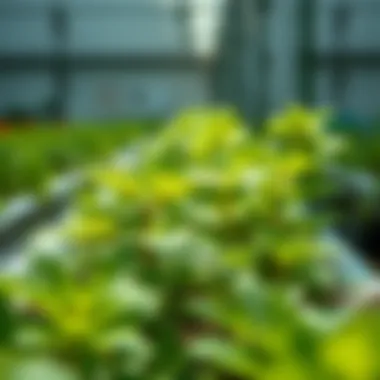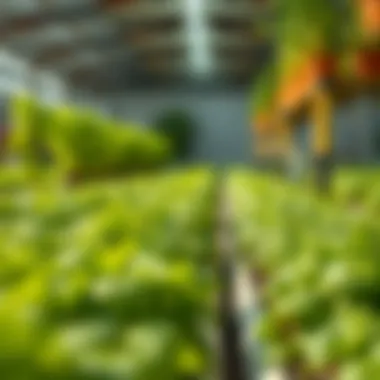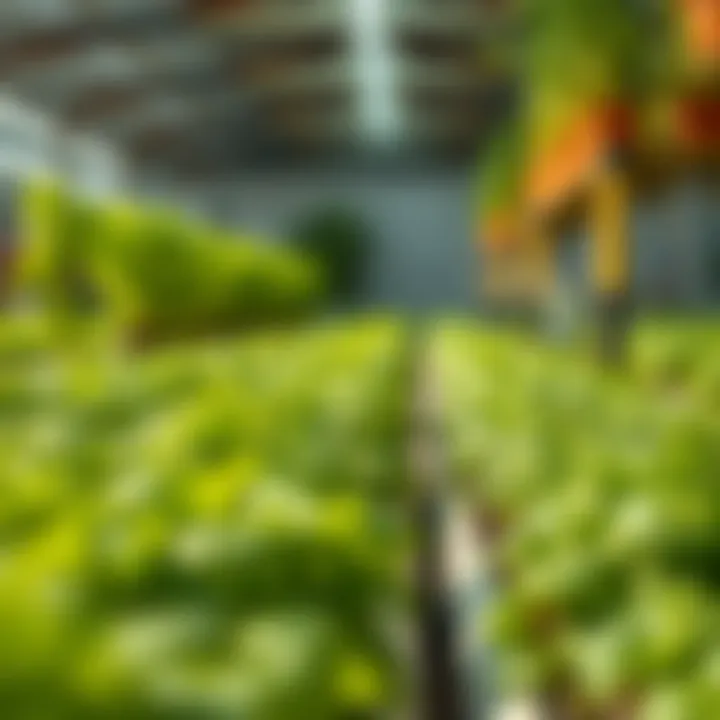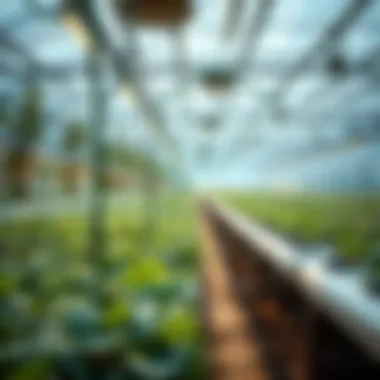Hydroponic Gardening: Principles and Benefits Explained


Intro
Hydroponic gardening is an innovative approach to growing plants without soil. Instead, it relies on nutrient-rich water solutions to deliver essential elements directly to the roots. This method has gained traction in recent years, thanks to its potential for increasing crop yields and minimizing resource use. Gardners and culinary enthusiasts alike are eyeing hydroponics as a viable and sustainable alternative to traditional farming. By delving into its mechanics and principles, one can appreciate how hydroponic systems work, the benefits they offer, and their transformative role in agriculture.
Latest Trends in Agriculture
Overview of Current Trends
In recent years, agriculture has seen a wave of modernization, pivoting from conventional techniques to more innovative practices. Hydroponics stands at the forefront of this shift. As urbanization rises, more people are looking at vertical farming and hydroponic setups as efficient ways to grow food within city limits. These systems not only save space but also reduce travel times for produce, ensuring fresher food reaches consumers.
Some notable trends include:
- Vertical farming: Using multi-layered systems to stack plant life, making the most of limited urban space.
- Automated systems: Modern hydroponics increasingly incorporates automation and smart technology to monitor plants' needs and adjust nutrient levels in real-time.
- Aquaponics: A hybrid approach that combines fish farming with hydroponics, creating a mutually beneficial ecosystem.
Impact of Technology on Farming Practices
Technology has played a crucial role in revolutionizing hydroponic gardening. From advanced sensors that measure pH levels to apps that track growth patterns, today's gardener possesses tools their predecessors could only dream about. Research institutions and universities are continuously working to optimize nutrient delivery methods and crop management software.
Through the exploration of new hydroponic systems, tech-savvy farmers can enhance efficiency, leading to better yields and greater sustainability. This is pivotal as climate concerns demand that food production methods adapt quickly.
Sustainable Practices: Towards a Greener Future
Importance of Sustainability in Agriculture
As climate change and resource depletion become pressing issues, sustainable practices in agriculture are no longer a luxury but a necessity. Hydroponics, in its various forms, minimizes water usage by up to 90% compared to traditional farming. This is vital because water scarcity is hitting many regions hard. Furthermore, the closed-loop systems in hydroponics reduce fertilizer runoff, which is a significant cause of water pollution.
Methods for Sustainable Farming
- Water recycling: Systems can be designed to recirculate water, ensuring minimal waste.
- Organic nutrient solutions: Utilizing compost teas and natural fertilizers avoids harsh chemicals, promoting healthier plant growth and ecological balance.
- Integration with renewable energy: Solar panels can power hydroponic setups, enhancing sustainability and reducing operational costs.
Gardening Techniques and Tips
Essential Gardening Tools and Equipment
Starting with hydroponics does require some specific tools and setups, but don’t fret. Knowing what you need keeps things straightforward. Here’s a condensed list of essentials:
- Reservoirs: Tanks to hold your nutrient solution.
- Grow lights: Specifically designed lights that mimic sunlight, encouraging plant growth.
- PH and EC meters: For measuring water chemistry and ensuring the right balance of nutrients.
Seasonal Gardening Practices
Even in a controlled environment such as hydroponics, it’s essential to consider seasonal changes. Planting schedules can vary based on the crops you choose. While some may thrive in warmer temperatures, others prefer cooler conditions. Being aware of these needs can help optimize growth cycles and yields, ensuring that you get the most out of your hydroponic garden.
"Hydroponic gardening not only represents a leap forward in agricultural techniques but also reflects our growing commitment to sustainability." – Agricultural Innovator
By understanding the principles of hydroponic gardening and its implications for sustainable agriculture, gardeners can make informed decisions that contribute to a more responsible food production system. As we move forward, it becomes increasingly vital to embrace methods that guarantee food security while minimizing our ecological footprint.
Foreword to Hydroponic Gardening
Hydroponic gardening is not just a passing fad; it is a powerful method of growing plants without soil that has piqued the interest of backyards and commercial growers alike. This article seeks to unveil the nuances of hydroponics, demystifying its principles and revealing its myriad advantages and challenges.
In an era where urbanization is rampant and land for traditional farming shrinks, hydroponics emerges as a relevant alternative. Understanding its mechanisms can help aspiring gardeners and seasoned farmers alike to adapt to changing agricultural landscapes. Moreover, being familiar with this innovative approach can significantly enhance food security, contribute to sustainability, and offer efficient growth options.
Definition and Principles
At its core, hydroponics is about growing plants in a nutrient-rich solution rather than soil. This method focuses on providing plants with the essentials they need to thrive: water, nutrients, and sunlight. The roots are submerged, allowing them to directly absorb the nutrients from the water. This system eliminates many pests and diseases that can be found in soil, enhancing plant health and productivity.
Hydroponic systems capitalize on the idea that plants can flourish when their nutritional requirements are met precisely. The principles of hydroponics are rooted in the understanding of plant biology, ensuring that the vital elements such as nitrogen, phosphorus, and potassium are available in just the right quantities. This allows for optimal growth conditions where plants can achieve faster growth rates and greater yields compared to traditional soil-based gardening.
Historical Context
Though modern hydroponics seems like a recent revelation, its roots trace back to ancient civilizations. The Hanging Gardens of Babylon, one of the Seven Wonders of the Ancient World, is often considered an early example of soilless plant cultivation. Fast-forward a few centuries, and in the 17th century, scientists began to formalize hydroponic practices. Notably, the work of Pierre D. Sydenham and later, Dr. William F. Gericke who coined the term in the 1930s, laid the groundwork for what we recognize as hydroponics today.
Since then, hydroponics evolved, especially during the mid-20th century when scientists explored methods to increase food production amidst rising global population pressures. From simple systems with small containers to intricate, automated environments, the journey of hydroponics highlighted its potential across various applications, from urban gardens to commercial farms.
In summary, hydroponic gardening offers fresh perspectives on cultivation, bridging ancient practices with modern techniques. As we delve deeper into this article, we will dissect the various systems, components, and challenges it entails while drawing connections on how this technique can significantly impact our food production, sustainability efforts, and even urban landscapes.
Types of Hydroponic Systems
Hydroponic systems represent a fascinating and innovative way to cultivate plants without soil, relying solely on nutrient-rich water solutions. Understanding the various types of hydroponic systems is fundamental for anyone considering this method of gardening. Each system has distinct features, benefits, and considerations, which can greatly impact growth rates, yield, and maintenance requirements.
Nutrient Film Technique


The Nutrient Film Technique, often abbreviated as NFT, is a method where a thin film of nutrient solution circulates over the roots of plants. This setup allows plants to absorb water and nutrients efficiently.
- Benefits: NFT systems are particularly advantageous for crops that have shorter growth cycles, such as lettuce and herbs. The constant flow ensures roots receive adequate aeration.
- Considerations: However, a potential drawback is that if the power goes out or the pump fails, the thin film can dry out quickly, stressing the plants. A backup power source may be wise in areas prone to outages.
Deep Water Culture
In the Deep Water Culture (DWC) method, plant roots are submerged in a nutrient-rich water solution, with air stones supplying oxygen directly to the roots. This technique is known for promoting rapid growth.
- Benefits: DWC offers significant growth rates, making it attractive for commercial operations as it is easy to scale. Additionally, the oxygenation from the air stones enhances root health.
- Considerations: However, monitoring pH and dissolved oxygen levels becomes crucial, as fluctuations can impact plant health negatively. Understanding these parameters is essential for maintaining a successful system.
Aeroponics
Aeroponics take plant growth to new heights by suspending plants in air and misting their roots with a nutrient solution. This system maximally uses space and resources.
- Benefits: The high level of oxygen exposure enhances growth rates significantly. Moreover, this method uses even less water than traditional hydroponics, creating an efficient alternative in water-scarce regions.
- Considerations: On the flip side, aeroponics can be more technically demanding, requiring precise timing and monitoring of the misting system, which can pose challenges for novice gardeners.
Ebb and Flow Systems
Ebb and Flow systems, also known as flood-and-drain systems, operate by periodically flooding the growing area with nutrient solution and then draining it away. This cycle allows for effective nutrient uptake.
- Benefits: The intermittent flooding reduces the risk of over-saturation and promotes healthy root growth. It is versatile, allowing growers to cultivate a wide range of plants.
- Considerations: Such systems may require more frequent maintenance checks to ensure pumps are functioning correctly and that standing water does not promote algae growth.
Wicking Systems
Wicking systems involve a passive approach where a growing medium is saturated with nutrient solution via a wick, drawing moisture to the plants as needed.
- Benefits: Ideal for beginners, these systems are simple, inexpensive, and require minimal technology. They can effectively support a variety of plants, including some root vegetables.
- Considerations: Nonetheless, they generally have slower growth rates and may not be suitable for larger plants or those with high water demands.
The spectrum of hydroponic systems demonstrates the different ways one can engage with this method of gardening. Selecting the right system that aligns with both personal preferences and available resources can enhance the garden's productivity and sustainability.
For further resourceful insights and tips on hydroponic gardening, websites such as Wikipedia, Britannica, and farmers' forums on Reddit can provide valuable information.
Components of Hydroponic Systems
In hydroponic gardening, the components of the system serve as the foundation on which the success or failure of the endeavor rests. Each element plays a critical role, and understanding their interconnectivity is essential for those looking to adopt this innovative form of agriculture. With the right configuration, hydroponics can optimize growth, conserve resources, and provide a steady supply of food with fewer environmental impacts. Therefore, comprehending these crucial components is necessary for anyone who seeks to delve deep into hydroponics.
Growing Mediums
The choice of growing medium in hydroponics is of paramount importance. Unlike traditional soil gardening, hydroponics requires a substitute that can support plant roots while allowing for efficient nutrient and water delivery. Commonly used mediums include coconut coir, perlite, and rock wool.
- Coconut Coir: Derived from the husks of coconuts, coir is both sustainable and effective. It has excellent moisture retention properties, allowing plants to thrive without the risk of overwatering.
- Perlite: This is a volcanic glass that’s heated until it expands. Perlite is lightweight and provides great aeration for roots, preventing them from becoming waterlogged.
- Rock Wool: Made from basalt rock, it’s perhaps one of the most popular mediums in hydroponics. Rock wool offers superb insulation and retains moisture well, but its pH neutral characteristics need to be managed carefully.
Choosing the right growing medium impacts not only plant health but also the overall efficiency of the hydroponic system. Each medium has specific advantages and drawbacks, making careful consideration essential.
Nutrient Solutions
The nutrient solution is the lifeblood of any hydroponic operation. It's essentially a mix of water and essential nutrients that plants need to grow. Critical elements in these solutions typically include nitrogen, phosphorus, potassium, as well as micronutrients like iron and magnesium.
- Tailored Solutions: Different plants have unique nutritional requirements. For instance, leafy greens may thrive on higher nitrogen levels, while fruiting plants might need increased potassium. Customizing the nutrient solution can yield better growth and more robust flavors.
- pH Balance: Maintaining the right pH, usually between 5.5 and 6.5 for most plants, is crucial for nutrient availability. If the pH strays too far from this range, plants may struggle to absorb essential nutrients, leading to stunted growth or deficiencies.
Many growers use commercial nutrient solutions or can prepare their own, but attention to the balance is key. A well-managed nutrient solution not just feeds the plants, it fosters an environment where they can flourish.
Water Quality Management
Water quality management is often overlooked but is equally vital in hydroponic gardening. Not all water is created equal; the presence of impurities, chemicals, or residual chlorine can adversely affect plant health.
- Testing Water: It's recommended to start with a baseline analysis of water quality. Parameters such as total dissolved solids (TDS) and electrical conductivity (EC) give insights into the water's nutrient load, while microbial testing can ensure its cleanliness.
- Treatment Methods: Common methods for ensuring water quality include filtration and reverse osmosis. These processes help eliminate unwanted particles and chemicals that could disrupt the growth environment.
"Quality water, like good food, feeds our plants right. If you don’t start with pure, clean water, the rest of the system doesn’t matter much."
By addressing water quality, growers can secure healthy root systems and promote vigorous growth. This foundational aspect ultimately reflects in the yield and quality of the produce.
Understanding these components sets the groundwork for deeper exploration into the advantages, challenges, and future of hydroponics as a sustainable agricultural practice.
Advantages of Hydroponic Gardening
Hydroponic gardening stands as a beacon of innovation in the agricultural realm, combining science with practical growing techniques. Its advantages can give growers an edge, not just in yield, but in sustainability and resource management. These benefits are reaping dividends for urban farmers and agricultural enthusiasts alike. Below, we will explore several key advantages that make hydroponics a game-changer in the gardening world.
Space Efficiency
One of the most striking advantages of hydroponic gardening is how it maximizes space. In urban settings, where real estate is as precious as gold, traditional gardening can run into problems. Hydroponic systems can utilize vertical gardening styles, allowing plants to grow upward rather than outward. This approach can fit an impressive number of plants into a smaller footprint, making it perfect for rooftops, balconies, and small backyards.
What's particularly interesting is how these systems don't need soil. Instead, they rely on growth media options like rockwool or clay pellets, which free up additional space. As a result, it's not uncommon to see hydroponic gardens yielding more produce per square foot than their soil-based counterparts. For city dwellers, this is sheer gold.


Faster Growth Rates
In hydroponics, plants often experience faster growth rates compared to traditional gardening methods. The reason? Plants get a direct line to vital nutrients. In a hydroponic setup, nutrients are dissolved in water and delivered directly to the plant roots. This rapid access to food encourages quicker growth cycles, leading to harvesting in a fraction of the time.
Research has shown that some leafy greens will reach maturity up to 30% faster in hydroponic systems. For example, basil, a popular herb, can go from seed to harvest in just a few weeks. Imagine that speed when aiming for your next culinary masterpiece.
Reduced Water Usage
Water scarcity has become a pressing global issue, and here, hydroponic gardening takes a giant leap forward. By using nutrient solutions recirculated in a closed loop, hydroponics uses significantly less water than traditional farming. Reports suggest that hydroponic systems can use as much as 90% less water.
This remarkable efficiency is achieved largely because there is no water runoff or evaporation as is common with soil gardening. Instead of water pouring through the soil and being lost, it gets reused multiple times until the plants have extracted every nutrient they need. In a world where every drop counts, hydroponics could be a keystone method of sustainable agriculture.
Pest and Disease Management
Pest control is always a headache for growers, but hydroponics offers a unique advantage here, too. With indoor hydroponic systems, there's a marked reduction in vulnerability to soil-borne diseases and pests. The controlled environment means you can leverage preventive measures more effectively, such as using natural predators or organic pesticides.
Moreover, the closed systems often allow for easier monitoring. If pests do appear, they can be spotted and addressed quickly, before they turn into a larger problem. Educational institutions are even using hydroponics to teach students about integrated pest management as part of sustainable practices.
"In student-run hydroponic systems, we can teach about the relationship between pest management and plant health, ensuring future generations are well-equipped to handle these challenges."
Challenges in Hydroponic Gardening
Hydroponic gardening is often touted as the wave of the future in agriculture, and while its potential is immense, it's crucial to address the inherent challenges that come along with it. Acknowledging these hurdles is not only important for those already familiar with hydroponics but also for newcomers who might be considering this method as a viable alternative to traditional gardening. By understanding the complexities involved, growers can devise strategies that will help them avoid pitfalls, thus enhancing their chances of success.
Initial Setup Costs
One of the first hurdles prospective hydroponic gardeners encounter is the initial setup cost. Unlike traditional gardening, which may require merely soil, seeds, and water, hydroponics demands a more substantial investment in equipment and materials. This can range from specialized growing systems, such as NFT channels or deep water culture tanks, to pumps, lights, and nutrient solutions. The upfront expense may raise eyebrows, yet it’s worthwhile to consider the long-term benefits.
A well-planned hydroponic system can yield crops faster and more efficiently than conventional methods, offering potential returns on investment much sooner than expected. However, one has to weigh the cost of various components, possibly seeking second-hand equipment or DIY alternatives to mitigate these expenses.
"Investing in quality equipment now can save headaches down the line as it tends to lead to better yields and less maintenance."
Technical Expertise Requirement
Another considerable challenge is the technical expertise required to run a hydroponic system effectively. It's not just a matter of pouring water over plants; understanding pH levels, nutrient balance, and system design shapes the backbone of hydroponic success. For many, this may seem overwhelming.
Learning the ropes demands time and commitment. Engaging with online forums, tutorials, or even local workshops can prove invaluable. Many communities offer resources that cater to those eager to learn about the science behind hydroponics. In essence, while some may view the required knowledge as a barrier, it can also become a gateway to a rewarding pursuit.
System Failures and Reliability Issues
No system is immune to failure, and hydroponics is no exception. Reliance on technology means that one minor hiccup—such as a pump breakdown—can lead to dire consequences for your plants. Water quality issues can arise suddenly too, potentially affecting nutrient absorption, and thus overall plant health. Therefore, it's crucial to have contingency plans in place.
Regular maintenance checks and monitoring are critical. Setting up alerts for system malfunctions or investing in redundant systems can mitigate these risks substantially. Moreover, understanding how to troubleshoot common problems will arm gardeners with knowledge that can save their crops in times of crisis.
In summary, although the path of hydroponic gardening is fraught with challenges, awareness and preparation can turn these obstacles into manageable tasks. In understanding the initial costs, technical requirements, and potential failures, growers can lay the groundwork for fruitful outcomes. Becoming skilled in these areas not only fosters confidence but empowers individuals to touch the very future of sustainable farming.
The Role of Technology in Hydroponics
In the rapidly advancing field of hydroponics, the role of technology cannot be overstated. It effectively bridges the gap between traditional cultivation methods and modern agricultural practices. For both amateur growers and seasoned farmers, integrating technology enhances not only efficiency but also crop yields. This section focuses on two specific aspects of technological integration in hydroponics: Automation and Monitoring, as well as Data Collection and Optimization.
Automation and Monitoring
Automation has become an absolute game-changer in hydroponic gardening. By automating various processes, growers can save time, reduce labor costs, and minimize human error. Systems like nutrient pumps, timers, and environmental monitors ensure that plants receive optimal support without constant manual intervention.
- Nutrient Delivery: Automated nutrient dosing systems can precisely regulate the nutrient solutions supplied to plants. This consistency in feeding helps mitigate issues such as over-fertilization, which can be detrimental.
- Climate Control: Automated climate systems manage temperature, humidity, and light levels, adjusting them according to the needs of the plants. For instance, if humidity rises unexpectedly, the system can activate dehumidifiers, thus preventing mold growth.
Moreover, monitoring technology allows growers to keep track of environmental conditions in real-time. Devices equipped with sensors can relay data about pH levels, electrical conductivity, and and light intensity directly to the user. This data fuels responsive adjustments, ensuring that plants thrive:
"In hydroponics, being proactive can be the difference between a flourishing garden and a withering one."
The integration of technologies like IoT (Internet of Things) has revolutionized how growers perceive and interact with their hydroponic systems.
Data Collection and Optimization
Data is the lifeblood of effective hydroponic gardening. Recording various metrics—like growth rates, nutrient absorption, and environmental conditions—can provide critical insights for optimizing a systems performance. By analyzing this data, farmers can hone in on what works best for their specific plants.
- Predictive Analytics: Utilizing machine learning algorithms can help forecast plant growth trends, paving the way for more informed decisions about when to plant, feed, or harvest.
- Problem Solving: If a crop isn't performing as expected, a thorough analysis of the collected data can help identify the root cause. Maybe it was too much light or inadequate water levels; the data will point you in the right direction.
- Customized Growth Conditions: With advanced data collection techniques, growers can tailor their environments to the specific needs of the plants. For example, different types of lettuce may require varying nutrient concentrations. Using this data, farmers can create unique growing profiles, essentially optimizing each batch for maximum yield.
Ultimately, the role of technology in hydroponics embodies a proactive approach to gardening. By leveraging both automation and data collection, growers are not just managing a garden; they're creating a thriving ecosystem that fosters growth and sustainability.
Applications of Hydroponic Gardening
Hydroponic gardening presents numerous opportunities across various sectors, significantly impacting urban landscapes, education systems, and commercial agricultural practices. The unique ability of hydroponics to produce food without traditional soil cultivation opens up fresh pathways for how we grow and distribute food. This section explores these applications, emphasizing their relevance in today's fast-evolving agricultural world.


Urban Agriculture
Urban agriculture is one area where hydroponic systems truly shine. In crowded cities where space is at a premium, hydroponics offers a smart solution to food production challenges. For instance, rooftop gardens or vertical farms allow city dwellers to cultivate fresh produce right above their heads. These setups not only enhance food security but also reduce the carbon footprint associated with transporting goods over long distances.
Consider a scenario where a small grocery store sources its leafy greens from a nearby hydroponic farm instead of importing them hundreds of miles away. This not only ensures freshness but also supports local economies. Moreover, urban hydroponics can contribute to reducing food deserts—areas where access to fresh produce is limited—by placing farms directly in the heart of communities. Hydroponic systems in urban settings can yield impressive harvests without requiring vast tracts of land, making it a practical option not just for efficiency but for environmental sustainability.
Educational Institutions
Hydroponic gardening has also found significant traction within educational institutions. Schools and universities are adopting hydroponic systems as a hands-on learning experience for students. Such initiatives engage students in science, sustainability, and agricultural practices without the need for extensive outdoor space. For instance, classrooms can install small hydroponic setups that allow students to observe plant growth and nutrient absorption first-hand.
These educational programs can ignite curiosity about biology and environmental science, ultimately fostering a new generation of eco-conscious individuals. Understanding these principles through hydroponics can help students appreciate the importance of food production, water management, and sustainable practices. A local high school in California might implement a hydroponic curriculum that not only provides fresh vegetables for the cafeteria but also teaches students about responsible agriculture and resource conservation, seamlessly merging theory with practice.
Commercial Production
The commercial sector stands to gain enormously from hydroponic gardening. Large-scale hydroponic facilities can produce high yields year-round, thanks to the controlled environments they offer. Such operations can focus on specific crops that command higher market prices, such as herbs, leafy greens, or strawberries, which often yield better quality and flavor when grown in hydroponic systems.
In this space, efficiency is key. Businesses can use data-driven approaches to optimize nutrient solutions and ensure the best growth conditions, leading to increased profitability. For example, a hydroponic farm in New York may use advanced monitoring systems to track plant growth and make real-time adjustments to light and nutrient levels, maximizing output. This kind of precision agriculture not only boosts productivity but also minimizes waste, as resources are utilized more efficiently compared to traditional farming methods.
The adaptability of hydroponic systems makes them suitable for various scales, from personal setups in homes to expansive commercial operations.
As we dive deeper into the world of hydroponics, it's clear that its applications extend beyond conventional boundaries, fostering innovative practices that can redefine how we think about food production and consumption in our modern society.
For further reading, you can check resources like Wikipedia or Britannica for additional insights.
Sustainability and Hydroponics
Sustainability has become a buzzword of sorts in many sectors, but when it comes to hydroponic gardening, it carries significant weight. As urban areas continue to expand and farmland diminishes, the need for sustainable practices in agriculture is more pressing than ever. Hydroponics, which allows for soil-less plant growth, exemplifies how innovative farming techniques can contribute to sustainability. It maximizes resource efficiency, minimizes waste, and ultimately paves the way for a more secure food supply.
One of the core benefits of hydroponics lies in its ability to produce food using substantially less water than traditional farming methods. In fact, studies suggest that hydroponic systems can use up to 90% less water. This is achieved through closed-loop systems where water is recycled, significantly reducing the overall consumption. Additionally, by growing crops indoors or in controlled environments, hydroponics can mitigate the adverse effects of climate change, such as pest outbreaks and extreme weather, thereby enhancing food security in a world facing unpredictable challenges.
"Harnessing the power of hydroponics may very well be a cornerstone in the quest for sustainable food production as we grapple with dwindling resources and rising populations."
Impact on Food Security
Food security is not just about having enough food; it's about ensuring quality, accessibility, and the ability to produce food regardless of external conditions. Hydroponic systems can be set up in urban environments and even in regions prone to drought or poor soil quality. This flexibility allows communities to produce fresh produce locally, reducing dependence on long supply chains that can be disrupted. Moreover, with the rise in awareness regarding healthy eating, hydroponic farms often yield crops that have superior flavor, nutritional content, and overall quality compared to those harvested through conventional methods.
Another dimension of hydroponics is its contribution to shortening the time from farm to table. By growing food within city limits, consumers can access fresher products with a smaller carbon footprint associated with transport. This accessibility not only enhances public health but also empowers local economies.
Challenges to Sustainable Practices
However, there are challenges that must be addressed to make hydroponic gardening fully sustainable. One pressing issue is the reliance on synthetic nutrient solutions. While these products aid in plant growth, their production and usage can raise questions regarding long-term ecological impacts. The challenge lies in developing organic alternatives that are effective yet remain economically viable.
Another hurdle is the energy consumption of indoor hydroponic systems, especially when relying on artificial lighting. A shift towards renewable energy sources could ameliorate this issue, but technology and infrastructure investments are required, which can be daunting for small-scale operators.
To summarize, here are some key points regarding sustainability and hydroponics:
- Resource Efficiency: Hydroponics uses less water and space compared to traditional farming.
- Local Production: It allows for food to be grown near urban centers, enhancing accessibility and freshness.
- Quality of Produce: Hydroponically grown crops can be more nutritious and flavorful.
Yet, with great potential also comes responsibility. The future of sustainable practices in hydroponics will need to focus on minimizing negative environmental impacts, improving energy consumption, and ensuring that the nutrients used are eco-friendly. Balancing these facets is essential for making hydroponic gardening a cornerstone of future food production.
Future Prospects of Hydroponic Gardening
The future of hydroponic gardening is promising and multifaceted, bringing numerous advancements that could reshape the agricultural landscape. The shift toward hydroponics is not merely a trend; it is fueled by necessity as the global population surges, urban spaces expand, and sustainable practices become more critical. Farmers and enthusiasts alike are recognizing that hydroponics offers a solution to land scarcity, water shortages, and the demand for fresh produce in cities without arable land.
Innovative Research and Development
In the realm of hydroponics, research and development are continually evolving, revealing practices that improve both efficiency and output. Scientists are experimenting with various growing mediums, nutrient formulations, and plant varieties specifically suited for hydroponic environments. Advances in technology, such as artificial intelligence and IoT, are making it possible to monitor plant health more effectively than ever.
Key areas of innovation may include:
- Nutrient Optimization: Discovering optimal concentrations and combinations of nutrients that promote plant growth without waste.
- Germination Techniques: Developing pre-germination processes that allow seeds to sprout faster, ensuring quicker harvest times.
- Automated Systems: Integrating sensors and automation technologies to minimize human error and streamline maintenance tasks.
Research institutions are collaborating with agricultural tech startups and universities to push the boundaries of what is possible in hydroponic gardening. Such partnerships reveal that the future could hold significant leaps in crop yields and disease resistance.
“As we unlock the potential of hydroponics through research, we not only improve our food systems but also pave the way for future innovations in sustainable agriculture,” says Dr. Emily Reyes, a leading agronomist in the field.
Potential Market Growth
The market for hydroponics is set to soar in the coming years, and here's why. Consumers are drawn to sustainable agricultural practices, and hydroponics directly addresses key concerns about food sourcing and environmental impact. With more people seeking locally grown, fresh produce, hydroponic systems can thrive in urban and suburban areas, making them a viable business choice.
Factors contributing to market growth include:
- Rising Demand for Organic Produce: Health-conscious consumers are increasingly looking for chemical-free options, and hydroponic vegetables often meet these standards.
- Urbanization: As more people flock to cities, the need for efficient urban farming solutions turns hydroponic systems into a lucrative opportunity for budding agripreneurs.
- Climate Change Awareness: Hydroponics uses significantly less water compared to traditional farming methods, making it attractive to eco-conscious farmers as climate issues escalate.
- Government Incentives: Various governments are introducing policies that encourage urban agriculture, providing incentives for individuals and businesses to invest in hydroponics.
With projections indicating a substantial increase in the hydroponics market over the next decade, both established businesses and new ventures stand to gain from this agricultural revolution. Industry professionals should keep their ears to the ground, as new trends and technologies emerge, shaping the future of food production in ways we are just beginning to understand.
As we navigate these evolving landscapes in hydroponic gardening, one misconception must be addressed: hydroponics is not just a solution for serious farmers; it is accessible for anyone interested in cultivating their greens, whether for personal use or commercial ventures.
For further reading on the evolution and commercialization of hydroponics, visit sources like WIkipedia or delve deeper into studies at Britannica.







